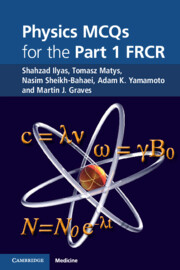Book contents
- Frontmatter
- Contents
- Preface
- Acknowledgements
- 1 Basic physics
- 2 Radiation hazards and protection
- 3 Imaging with X-rays
- 4 Film-screen radiography
- 5 Digital radiography
- 6 Fluoroscopy and mammography
- 7 Nuclear medicine
- 8 Computed tomography
- 9 Imaging with ultrasound
- 10 Magnetic resonance imaging
- Bibliography
- Index
8 - Computed tomography
Published online by Cambridge University Press: 05 July 2011
- Frontmatter
- Contents
- Preface
- Acknowledgements
- 1 Basic physics
- 2 Radiation hazards and protection
- 3 Imaging with X-rays
- 4 Film-screen radiography
- 5 Digital radiography
- 6 Fluoroscopy and mammography
- 7 Nuclear medicine
- 8 Computed tomography
- 9 Imaging with ultrasound
- 10 Magnetic resonance imaging
- Bibliography
- Index
Summary
Regarding computed tomography (CT) number (CTn):
It represents the linear attenuation coefficient of each tissue
It is directly proportional to μwater
It depends on kV, but not on filtration
It is between 20 and 30 for brain white matter
Air and water can be used for calibration of CTn
Regarding the partial volume effect:
A thin high-contrast object at an oblique angle is less visible
Because of the partial volume effect, a small high-contrast object that is smaller than the display pixel size is not visible
It reduces the visibility of low-contrast detail
It depends on the thickness of the tissue
It depends on the thickness of the transaxial slice
In CT:
The total number of detectors is around 500–1000 in each row
The gantry cannot tilt in the cranio-caudal direction
A bone algorithm improves the spatial resolution
The anode–cathode axis is perpendicular to the z-axis to reduce the heel effect
The main filter is usually 3 mm of aluminium
In CT geometry:
There are typically two focal spots and the smallest is 0.6 mm
The heating capacity is 0.4 MJ
The filter in first-generation scanners was copper to remove high-energy photons and aluminium for low-energy photons
Post-patient collimation is necessary in a multi-slice scanner to get an accurate thickness
[…]
Information
- Type
- Chapter
- Information
- Physics MCQs for the Part 1 FRCR , pp. 98 - 109Publisher: Cambridge University PressPrint publication year: 2011
